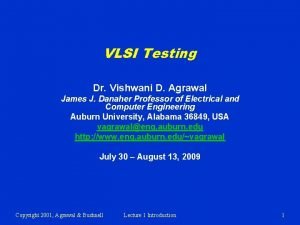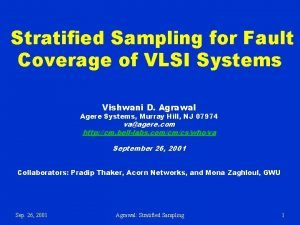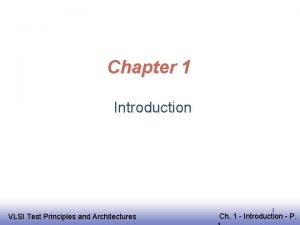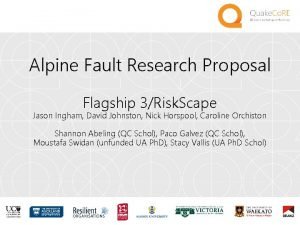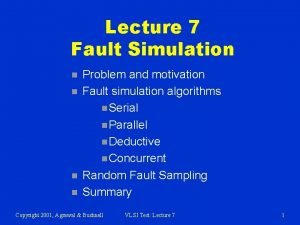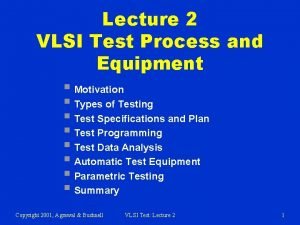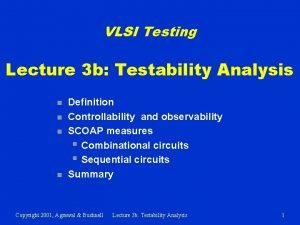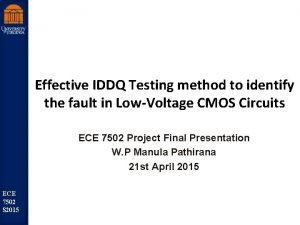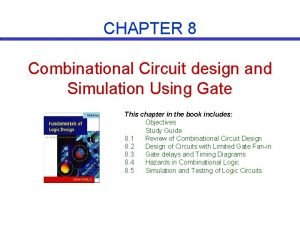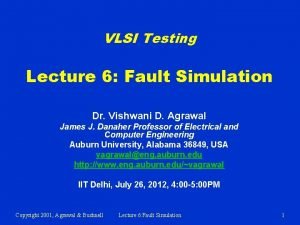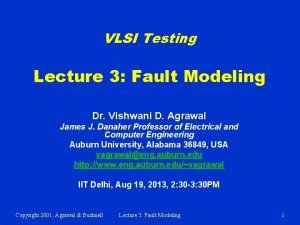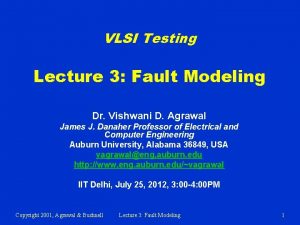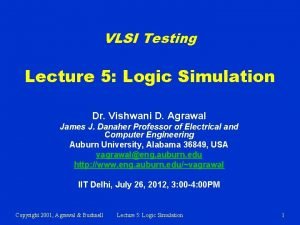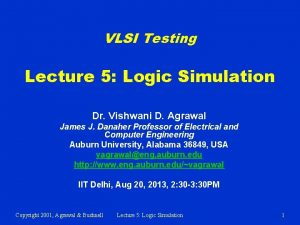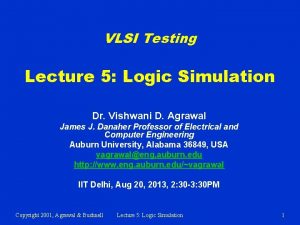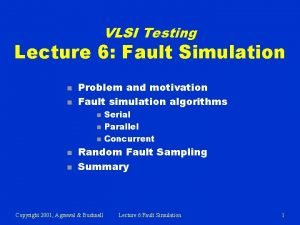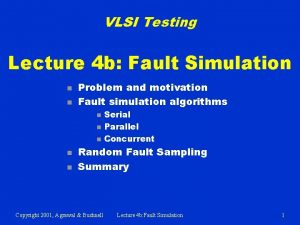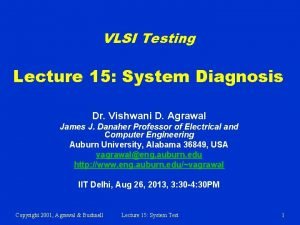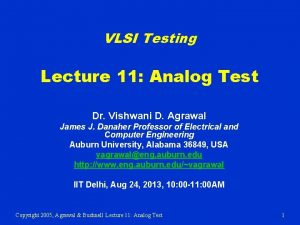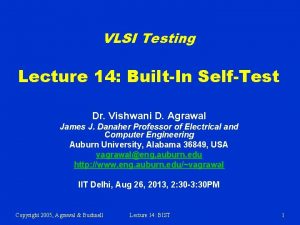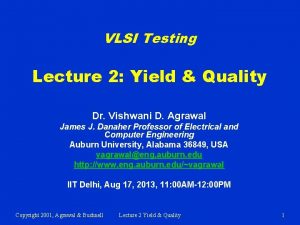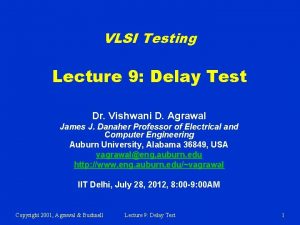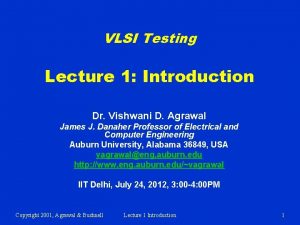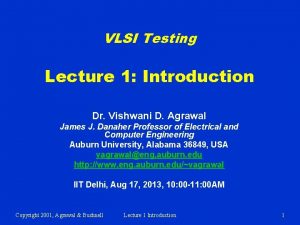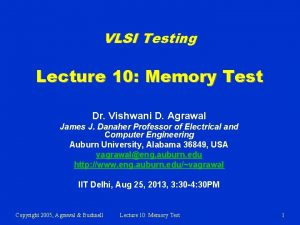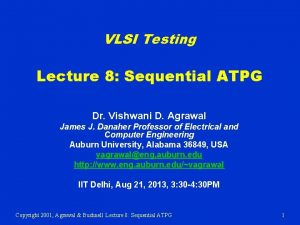VLSI Testing Lecture 6 Fault Simulation Dr Vishwani

















![Sampling Error Bounds |x-C|=3 [ C (1 - C ) 1/2 ────── Ns ] Sampling Error Bounds |x-C|=3 [ C (1 - C ) 1/2 ────── Ns ]](https://slidetodoc.com/presentation_image/502651be83cb7d49bb139d62cd1834d3/image-18.jpg)

- Slides: 19

VLSI Testing Lecture 6: Fault Simulation Dr. Vishwani D. Agrawal James J. Danaher Professor of Electrical and Computer Engineering Auburn University, Alabama 36849, USA vagrawal@eng. auburn. edu http: //www. eng. auburn. edu/~vagrawal IIT Delhi, Aug 20, 2013, 3: 30 -4: 30 PM Copyright 2001, Agrawal & Bushnell Lecture 6: Fault Simulation 1

Contents n n Problem and motivation Fault simulation algorithms n n n Serial Parallel Concurrent Random Fault Sampling Summary Copyright 2001, Agrawal & Bushnell Lecture 6: Fault Simulation 2

Problem and Motivation n Fault simulation Problem: Given § § § A circuit A sequence of test vectors A fault model Determine § § n Fault coverage - fraction (or percentage) of modeled faults detected by test vectors Set of undetected faults Motivation § § Determine test quality and in turn product quality Find undetected fault targets to improve tests Copyright 2001, Agrawal & Bushnell Lecture 6: Fault Simulation 3

Fault simulator in a VLSI Design Process Verified design netlist Verification input stimuli Fault simulator Test vectors Modeled Remove fault list tested faults Fault coverage ? Low Test Delete compactor vectors Test generator Add vectors Adequate Stop Copyright 2001, Agrawal & Bushnell Lecture 6: Fault Simulation 4

Fault Simulation Scenario n Circuit model: mixed-level n n n Signal states: logic n n n Mostly logic with some switch-level for high-impedance (Z) and bidirectional signals High-level models (memory, etc. ) with pin faults Two (0, 1) or three (0, 1, X) states for purely Boolean logic circuits Four states (0, 1, X, Z) for sequential MOS circuits Timing: n n Zero-delay for combinational and synchronous circuits Mostly unit-delay for circuits with feedback Copyright 2001, Agrawal & Bushnell Lecture 6: Fault Simulation 5

Fault Simulation Scenario (Continued) n Faults: n n n Mostly single stuck-at faults Sometimes stuck-open, transition, and path-delay faults; analog circuit fault simulators are not yet in common use Equivalence fault collapsing of single stuck-at faults Fault-dropping – a fault once detected is dropped from consideration as more vectors are simulated; faultdropping may be suppressed for diagnosis Fault sampling -- a random sample of faults is simulated when the circuit is large Copyright 2001, Agrawal & Bushnell Lecture 6: Fault Simulation 6

Fault Simulation Algorithms n n n Serial Parallel Deductive* Concurrent Differential* * Not discussed; see M. L. Bushnell and V. D. Agrawal, Essentials of Electronic Testing for Digital, Memory and Mixed-Signal VLSI Circuits, Springer, 2000, Chapter 5. Copyright 2001, Agrawal & Bushnell Lecture 6: Fault Simulation 7

Serial Algorithm n Algorithm: Simulate fault-free circuit and save responses. Repeat following steps for each fault in the fault list: n n Modify netlist by injecting one fault Simulate modified netlist, vector by vector, comparing responses with saved responses If response differs, report fault detection and suspend simulation of remaining vectors Advantages: n n Easy to implement; needs only a true-value simulator, less memory Most faults, including analog faults, can be simulated Copyright 2001, Agrawal & Bushnell Lecture 6: Fault Simulation 8

Serial Algorithm (Cont. ) n n Disadvantage: Much repeated computation; CPU time prohibitive for VLSI circuits Alternative: Simulate many faults together Test vectors Fault-free circuit Comparator f 1 detected? Comparator f 2 detected? Comparator fn detected? Circuit with fault f 1 Circuit with fault f 2 Circuit with fault fn Copyright 2001, Agrawal & Bushnell Lecture 6: Fault Simulation 9

Parallel Fault Simulation n n n Compiled-code method; best with two-states (0, 1) Exploits inherent bit-parallelism of logic operations on computer words Storage: one word per line for two-state simulation Multi-pass simulation: Each pass simulates w-1 new faults, where w is the machine word length Speed up over serial method ~ w-1 Not suitable for circuits with timing-critical and non-Boolean logic Copyright 2001, Agrawal & Bushnell Lecture 6: Fault Simulation 10

Parallel Fault Sim. Example Bit 0: fault-free circuit Bit 1: circuit with c s-a-0 Bit 2: circuit with f s-a-1 1 a b c s-a-0 detected 1 0 1 1 1 0 1 c e 1 0 1 s-a-0 0 d Copyright 2001, Agrawal & Bushnell f s-a-1 Lecture 6: Fault Simulation g 0 0 1 11

Concurrent Fault Simulation n n Event-driven simulation of fault-free circuit and only those parts of the faulty circuit that differ in signal states from the fault-free circuit. A list per gate containing copies of the gate from all faulty circuits in which this gate differs. List element contains fault ID, gate input and output values and internal states, if any. All events of fault-free and all faulty circuits are implicitly simulated. Faults can be simulated in any modeling style or detail supported in true-value simulation (offers most flexibility. ) Faster than other methods, but uses most memory. Copyright 2001, Agrawal & Bushnell Lecture 6: Fault Simulation 12

Conc. Fault Sim. Example a 0 0 a b 1 1 0 1 1 c d 1 c 0 b 0 1 1 0 0 0 e 0 0 0 1 Copyright 2001, Agrawal & Bushnell 0 1 1 e 1 0 0 f d 0 0 1 1 1 0 0 b 0 1 a 0 0 f 1 1 1 Lecture 6: Fault Simulation 1 0 g b 0 0 0 1 0 0 g 0 1 1 f 1 c 0 0 1 1 e 0 0 1 d 0 13

Fault Sampling n n A randomly selected subset (sample) of faults is simulated. Measured coverage in the sample is used to estimate fault coverage in the entire circuit. Advantage: Saving in computing resources (CPU time and memory. ) Disadvantage: Limited data on undetected faults. Copyright 2001, Agrawal & Bushnell Lecture 6: Fault Simulation 14

Motivation for Sampling n Complexity of fault simulation depends on: n n Number of gates Number of faults Number of vectors Complexity of fault simulation with fault sampling depends on: n n Number of gates Number of vectors Copyright 2001, Agrawal & Bushnell Lecture 6: Fault Simulation 15

Random Sampling Model Detected fault All faults with a fixed but unknown coverage Random picking Np = total number of faults Ns = sample size Ns << Np (population size) C = fault coverage (unknown) Copyright 2001, Agrawal & Bushnell Undetected fault c = sample coverage Lecture 6: Fault Simulation (a random variable) 16

Probability Density of Sample Coverage, c (x--C )2 ─ ────── 1 p (x ) = Prob(x < c < x +dx ) = ─────── s (2 p) p (x ) C (1 - C) 2 Variance, s = ────── Ns s C e 2 Sampling error s Mean = C C -3 s 1/2 2 s x C +3 s 1. 0 x Sample coverage Copyright 2001, Agrawal & Bushnell Lecture 6: Fault Simulation 17
![Sampling Error Bounds xC3 C 1 C 12 Ns Sampling Error Bounds |x-C|=3 [ C (1 - C ) 1/2 ────── Ns ]](https://slidetodoc.com/presentation_image/502651be83cb7d49bb139d62cd1834d3/image-18.jpg)
Sampling Error Bounds |x-C|=3 [ C (1 - C ) 1/2 ────── Ns ] Solving the quadratic equation for C, we get the 3 -sigma (99. 7% confidence) estimate: C 3 s = x ± 4. 5 ─── [1 + 0. 44 Ns x (1 - x )]1/2 Ns Where Ns is sample size and x is the measured fault coverage in the sample. Example: A circuit with 39, 096 faults has an actual fault coverage of 87. 1%. The measured coverage in a random sample of 1, 000 faults is 88. 7%. The above formula gives an estimate of 88. 7% ± 3%. CPU time for sample simulation was about 10% of that for all faults. Copyright 2001, Agrawal & Bushnell Lecture 6: Fault Simulation 18

Summary n n Fault simulator is an essential tool for test development. Concurrent fault simulation algorithm offers the best choice. For restricted class of circuits (combinational and synchronous sequential with only Boolean primitives), differential algorithm can provide better speed and memory efficiency. For large circuits, the accuracy of random fault sampling only depends on the sample size (1, 000 to 2, 000 faults) and not on the circuit size. The method has significant advantages in reducing CPU time and memory needs of the simulator. Copyright 2001, Agrawal & Bushnell Lecture 6: Fault Simulation 19
 Vishwani agrawal
Vishwani agrawal Fault coverage in vlsi
Fault coverage in vlsi Test principles in vlsi
Test principles in vlsi Cmos vlsi design lecture notes
Cmos vlsi design lecture notes Alpine fault simulation
Alpine fault simulation Deductive fault simulation
Deductive fault simulation Shmoo plot
Shmoo plot Controllability and observability in vlsi testing
Controllability and observability in vlsi testing What is iddq
What is iddq 01:640:244 lecture notes - lecture 15: plat, idah, farad
01:640:244 lecture notes - lecture 15: plat, idah, farad Combinational circuit design
Combinational circuit design Behavior testing adalah
Behavior testing adalah Globalization testing
Globalization testing Component testing is a black box testing
Component testing is a black box testing Decision table testing in software testing
Decision table testing in software testing Motivational overview of logic based testing
Motivational overview of logic based testing Table based testing
Table based testing Functional testing vs unit testing
Functional testing vs unit testing Types of domain testing
Types of domain testing What is decision table testing
What is decision table testing
